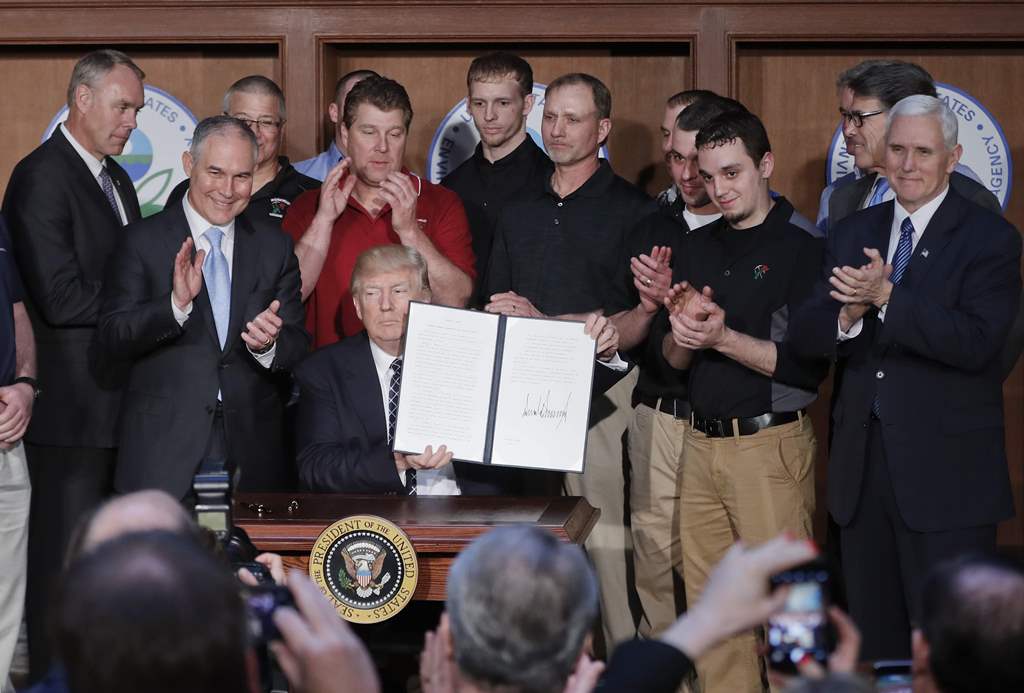Last Tuesday’s executive order leaves Americans high and dry in the face of climate risks
 President Donald Trump, accompanied by coal miners and, from left, Interior Secretary Ryan Zinke, Environmental Protection Agency (EPA) Administrator Scott Pruitt, second from right, Energy Secretary Rick Perry, and Vice President Mike Pence, far right, holds up the signed Energy Independence Executive Order, Tuesday, March 28, 2017, at EPA headquarters in Washington. (Photo: AP)
President Donald Trump, accompanied by coal miners and, from left, Interior Secretary Ryan Zinke, Environmental Protection Agency (EPA) Administrator Scott Pruitt, second from right, Energy Secretary Rick Perry, and Vice President Mike Pence, far right, holds up the signed Energy Independence Executive Order, Tuesday, March 28, 2017, at EPA headquarters in Washington. (Photo: AP)
Even climate-deniers agree risks of climate change are real, so why aren’t more Americans alarmed that Trump is playing politics with our lives?
It pains me to admit it, but my inner circle includes some climate deniers. If they weren’t related to me, I might be inclined to cut them from my life, like the Trump Administration has been cutting environmental regulations. But that would do everyone about as much good as Tuesday’s executive order will do for coal jobs in the US. Not much. After all, we need to be helping them (climate-deniers and coal miners) make the transition, not shutting them out.
Last Tuesday, with the stroke of his gold Cross pen, Trump undid a host of policies and regulations that protect the water we drink and the air we breathe, and set back the fight to protect the planet for our children and grandchildren. For me, someone who believes that human activity is causing climate change (along with virtually all of the experts on the subject) and works to address the climate challenge every day, this executive order was a big blow. But my fellow Americans, you should be concerned too.
Most Americans, even climate deniers, recognize the climate is changing
Most climate deniers now admit that the climate is changing. That it’s getting warmer, and that these changes affect people’s lives – frequently in negative ways. What they’re not so sold on is the degree to which humans have caused it. In fact, many people have experienced the effects first hand; whether its drought in California, wildfires in the West, Hurricane Sandy, flooding along the Gulf coast and in the upper Midwest or the more subtle changes in our weather that affects our ways of life. (As a Minnesotan, I’m thinking the shorter ice fishing season.)
So if we set skepticism about the contribution of greenhouse gases like carbon dioxide to climate change aside (even though the science on anthropogenic global warming is pretty solid), there is pretty broad consensus amongst both Republicans and Democrats that the climate is changing and that it poses a risk to people and businesses here in the US and abroad. In fact in 2016, 64 percent of Americans worried a great deal or fair amount about global warming.
The previous administration recognized these risks and took steps to ensure that we are prepared to respond to the challenges posed by climate change and are making good use of taxpayer dollars. Executive order 13653, “Preparing the US for the Impacts of Climate Change”, brought federal, state, and local actors together to manage the risks posed by climate change, invest in preparedness, and ensure business continuity to protect communities, our economy and the infrastructure and natural resources we all depend on. The Trump Administration closed the door on these efforts.
Resilience efforts are cost effective
There are a number of reasons to support federal efforts to prepare for the impacts of climate change, but there is one key reason that speaks to Trump’s rhetoric on spending taxpayer dollars wisely – that’s cost effectiveness.
Trump promised big investments in infrastructure. These projects are supposed to last 40-50 years or more. But if we want to build infrastructure that will last it’s critical to understand how the climate will effect these investments in the future. For example, storm sewers need to be built to hold future water levels and roads and bridges need to be able to withstand sea-level rise and other climate risks. It doesn’t make any sense to invest billions of taxpayer dollars in infrastructure that won’t last.
Preparedness and early response efforts save money and lives. The Government Accountability Office noted that federal spending on disaster relief in the US increased by 46 percent to $9.1 billion per year between 2007 and 2013. Sandy cost the Federal government $60 billion alone. Had the government invested early in preparedness strategies in communities at risk those bills could have been much lower. Experience continues to show that preparedness pays off. For every $1 invested in preparedness the return or savings is about $4, sometimes more.
Oxfam works with communities in the US and around the world dealing first hand with the impacts of climate change. Unfortunately, it’s often the poorest amongst us that feel the effects of climate change most severely. If Trump was serious about putting ‘America First’ he wouldn’t be leaving us high and dry in the face of growing climate risks.